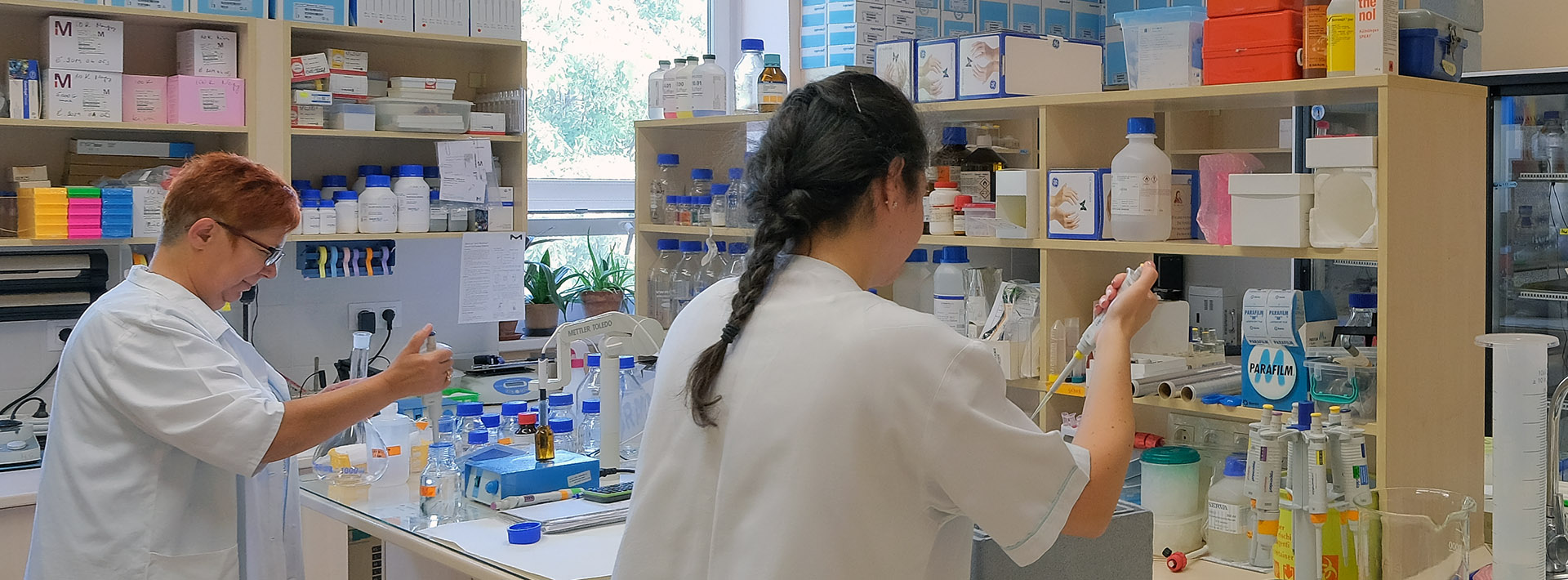Adatok
A Tantárgybejelentőben megadott hivatalos adatok az alábbi tanévre: 2024-2025
Tantárgyfelelős
-
Ujfalusi Zoltán
assistant professor,
Department of Biophysics
Óraszámok/félév
előadás: 28 óra
gyakorlat: 0 óra
szeminárium: 0 óra
összesen: 28 óra
Tárgyadatok
- Kód: OBA-106-E
- 2 kredit
- Biotechnology MSc
- Basic modul
- autumn
Nincs
Kurzus létszámkorlát
min. 5 fő – max. 100 fő
Tematika
The Biophysics curse aims to introduce students to the methods and applications, that are routinely used in both medical and pharmaceutical biotechnology. The principles of the state-of-the-art approaches and instrumentations are covered by the topics. The course presents diverse spectroscopic techniques (absorption, fluorescence, infrared, Raman, EPR, NMR), imaging approaches (light and fluorescence microscopy, EM, super-resolution fluorescence microscopy, MRI, CT), radioactive applications, calorimetry, and fast kinetics techniques. The lectures discuss in detail the physical bases and principles of each approach and the field of applications. The practices are dedicated to extending the students' knowledge and routine with the use of different techniques. The practices lay special emphasis on presenting not only the routine applications but advanced uses of each technique. The limitations, as well as the artifacts that can be caused by improper experimental planning, are highlighted.
Előadások
- 1.
Introduction. Structure of the atom, structure of the atomic nucleus, quantum mechanical model of the atom. Molecular orbitals, LCAO (linear combination of atomic orbitals), energy levels (Jabłonski).
- Ujfalusi Zoltán - 2.
Introduction. Structure of the atom, structure of the atomic nucleus, quantum mechanical model of the atom. Molecular orbitals, LCAO (linear combination of atomic orbitals), energy levels (Jabłonski).
- Ujfalusi Zoltán - 3.
Electromagnetic waves, the electromagnetic spectrum. The wave and particle nature of light.
- Grama László - 4.
Electromagnetic waves, the electromagnetic spectrum. The wave and particle nature of light.
- Grama László - 5.
Protein Structure. Introduction to protein engineering.
- Fekete Zsuzsanna - 6.
Protein Structure. Introduction to protein engineering.
- Fekete Zsuzsanna - 7.
Analytical separation techniques: chromatography, sedimentation, electrophoresis. Mass spectrometry.
- Takács-Kollár Veronika Tünde - 8.
Analytical separation techniques: chromatography, sedimentation, electrophoresis. Mass spectrometry.
- Takács-Kollár Veronika Tünde - 9.
Basics of light microscopy. Fluorescence microscopy, FRAP.
- Huberné Barkó Szilvia - 10.
Basics of light microscopy. Fluorescence microscopy, FRAP.
- Huberné Barkó Szilvia - 11.
Modern microscopic methods (STORM, STED, SIM, confocal, 2-photon).
- Szabó-Meleg Edina - 12.
Modern microscopic methods (STORM, STED, SIM, confocal, 2-photon).
- Szabó-Meleg Edina - 13.
High resolution structural approaches 1. Generation of X-ray, X-ray crystallography.
- Kapetanaki Sofia Maria - 14.
High resolution structural approaches 2. SAXS, EM, cryo-EM.
- Kapetanaki Sofia Maria - 15.
Infrared and Raman spectroscopy.
- Lukács András Szilárd - 16.
Infrared and Raman spectroscopy.
- Lukács András Szilárd - 17.
UV-VIS spectroscopy, absorption photometry. Fluorescence spectroscopy, Förster-type resonance energy transfer (FRET); Quenching, Rapid kinetic methods.
- Huberné Barkó Szilvia - 18.
UV-VIS spectroscopy, absorption photometry. Fluorescence spectroscopy, Förster-type resonance energy transfer (FRET); Quenching, Rapid kinetic methods.
- Huberné Barkó Szilvia - 19.
Thermodynamics, thermal analysis; Calorimetric methods: differential scanning calorimetry (DSC), isothermal titration calorimetry (ITC).
- Lukács András Szilárd - 20.
Thermodynamics, thermal analysis; Calorimetric methods: differential scanning calorimetry (DSC), isothermal titration calorimetry (ITC).
- Lukács András Szilárd - 21.
Fluid flow, LASER, Flow cytometry. Fluorescence activated cell sorting (FACS).
- Grama László - 22.
Fluid flow, LASER, Flow cytometry. Fluorescence activated cell sorting (FACS).
- Grama László - 23.
Spin. Electron spin resonance (ESR), nuclear paramagnetic resonance (NMR) spectroscopy.
- Grama László - 24.
Spin. Electron spin resonance (ESR), nuclear paramagnetic resonance (NMR) spectroscopy.
- Grama László - 25.
Medical imaging techniques in diagnostics 1. Positron emission tomography (PET), magnetic resonance imaging (MRI).
- Bukovics Péter - 26.
Medical imaging techniques in diagnostics 1. Positron emission tomography (PET), magnetic resonance imaging (MRI).
- Bukovics Péter - 27.
Medical imaging techniques in diagnostics 2. Gamma-camera, X-ray, computed tomography (CT), single-photon emission computed tomography (SPECT).
- Ujfalusi Zoltán - 28.
Medical imaging techniques in diagnostics 2. Gamma-camera, X-ray, computed tomography (CT), single-photon emission computed tomography (SPECT).
- Ujfalusi Zoltán
Gyakorlatok
Szemináriumok
A tananyag elsajátításához szükséges segédanyagok
Kötelező irodalom
Saját oktatási anyag
All handouts and other related materials can be found in the Microsoft Teams group of the course.
Jegyzet
Ajánlott irodalom
A félév elfogadásának feltételei
There are no additional conditions.
Félévközi ellenőrzések
Theory exams are scheduled in the exam period according to the rules of studies and examinations.
Távolmaradás pótlásának lehetőségei
The opportunity to make up for absence is not provided.
Vizsgakérdések
Topics of the exam questions:
Electromagnetic waves
Quantum numbers, NMR, MRI
Energy levels of atoms and molecules
Protein Structure. Introduction to protein engineering.
UV-VIS absorption spectroscopy
Fluorescence spectroscopy
Infrared and Raman spectroscopy
Flow cytometry
Light and fluorescence microscopy
Modern microscopic methods (STORM, STED, SIM, confocal, 2-photon)
Image analysis
Gamma camera, computed tomography (CT), single-photon emission computed tomography (SPECT), positron emission tomography (PET)
Radioactivity, the interaction of radioactive radiations with matter
Biological effects of radioactive radiations, dosimetry
X-ray crystallography, SAXS, EM
Thermodynamics: laws and thermodynamic potentials
Calorimetry: differential scanning calorimetry (DSC), isothermal titration calorimetry (ITC)
Analytical separation techniques: sedimentation, electrophoresis
Analytical separation techniques: chromatographic techniques
Mass spectrometry
Vizsgáztatók
- Bukovics Péter
- Fekete Zsuzsanna
- Grama László
- Huberné Barkó Szilvia
- Kapetanaki Sofia Maria
- Lukács András Szilárd
- Szabó-Meleg Edina
- Takács-Kollár Veronika Tünde
- Ujfalusi Zoltán
